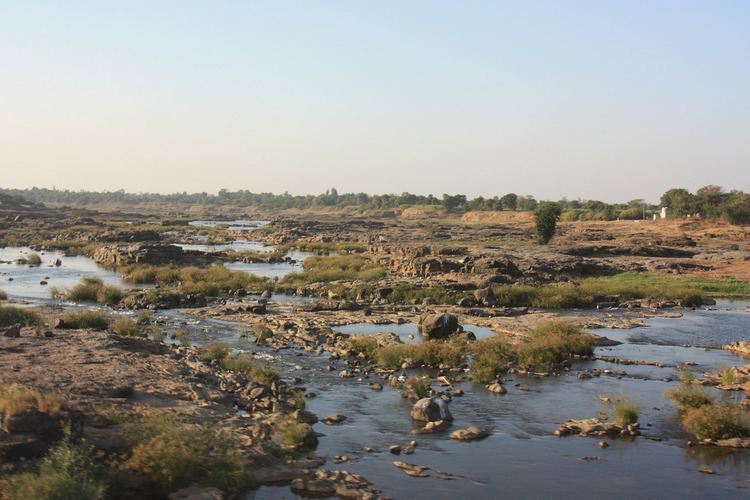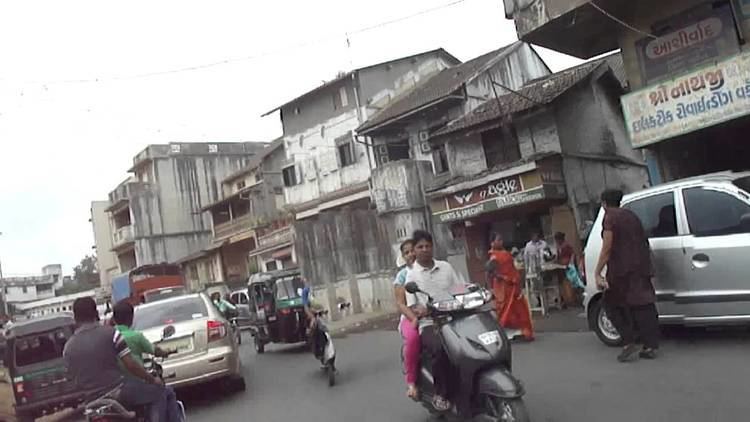Country Languages spoken Gujarati, Hindi District Navsari | ||
 | ||
Colleges and Universities Navsari Agricultural University, Daboo Law College | ||
Map of Navsari
Navsari is a city and municipality in the Surat Metropolitan Region and also the administrative headquarters Navsari District of Gujarat, India. Navsari is also the Twin City of Surat, and only 37 km south of Surat.
Contents
- Map of Navsari
- Coin miracles at sai baba mandir at unn navsari gujarat india 2nd june 2011
- S s agrawal public school navsari
- History
- Geography
- Demographics
- Etymology
- Landmarks
- Transportation
- Notable people
- Universities and colleges
- Schools
- Hospitals
- Indian street food vegetable kola puri tawa garlic naan freshly made while you wait
- Egg food stall lunsikui navsari
- Indian street food pillau rice at krishna pav bhaji stall lunsiqui navsari gujarat india
- References

Coin miracles at sai baba mandir at unn navsari gujarat india 2nd june 2011
S s agrawal public school navsari
History

Navsari, one of the oldest cities of Gujarat, has a history of over 2000 years. According to the Greek historical writings, a celebrated Egyptian astronomer and geographer named Ptolemy mentioned Navsari's port in his book written about 150 A.D. The geographic location he showed as Narispa, is in fact the Navsari of today.

The origin of the name "Navsari" has a very fascinating history. In the past, the city of Navsari has been associated with many names such as Nag Vardhana, Nag Shahi, Nag Sarika, Nag Mandal, Nav Sarika and Nav Sareh. Some of the legends associated with the various names of Navsari are as follows:
Shayashray Shiladitya, who ruled over Navsari in the seventh century named this city Nag Vardhaha in honour of his Guru Nag Vardhana. During the same period, the name changed to Nav Sarika as is evidenced by a recovered copper plate dated 669 A.D. The legend is that Shayashray Shiladttya presented a copper plate to a priest in his town. The copper plate read that Shiladitya, the ruler of "Nav Sarika," had bestowed a nearby village upon this priest of the Kashyapclan.
After subduing the rest of Gujarat, Umayyad conquerors were repulsed in the vicinity of Navsari in 120-21 AH/738-39 AD.
Another recovered copper plate dated 821 A.D. implies that the city's name later changed into Nag Sarika. The copper plate indicates that a Rashtrakut king named Kark Suvarna Varsh gave "Nag Sarika" as a gift to his teacher named AparaJeet, pupil of Sumati Kaharishi, who in turn was a pupil of the famous Digambar Jain teacher Acharya Mallavadi. There is a popular legend behind the name "Nag Sarika." Fables suggest that there was a big papal tree on the bank of a pond in the city. A huge cobra lived in a hollow of this tree. On this same tree, sarika, a singing bird, had her nest. As they resided in the same place, both became friends. Every day sarika entertained the cobra by singing her melodious tunes. The legend has it that due to this friendship between the Nag (cobra) and the sarika (singing bird), the city's name became popular as Nag Sarika.
Another legend of the Nag talks about the origins of a different name for the city: Nag Shahi. Historically, a Nag (Black Cobra) temple was situated next to a talav (pond) in the city. People worshiped the Black Cobra for its power and Prowess. Although the pond (talav) does not exist any more, the historical Nag Temple still exists in the area known as "Nag Talavdi". Hence the city came to be known as Nag Shahi, which means the power and prowess of the Black Cobra.
According to the Parsi tradition, in 1142 A.D., when they first came to Navsari, the city was named as Nag Mandal. The Parsis found the city's atmosphere similar to that of Sari region of Iran. In the Persian language, "now" means new and "Sari" refers to the region in Iran; hence the name Naoo Sari.
The fourteenth century marked the beginning of Muslim rule in Gujarat. Navsari came under the Muslim rule in the late sixteenth century when its name was changed to Nab Sareh. The anecdote is that according to the Muslim tradition, there were nine "Sarchs" of Muslims in the city and hence the name was derived as Nav (Nine) Sareh (Sarchs).
The above changes in names show that Navsari, like any other city, has passed through many vicissitudes in the matter of political reign. About fourteen hundred years ago, the kings of the Chalukya Dynasty governed the region of Navsari. Later, the Parsis, who migrated from Iran, virtually ruled this small town. The reign of the Parsis ended as the Muslim rulers took over. For the last one hundred years, until India's independence in 1947, Navsari was the property of the Gaekwads of Baroda.
Geography
Navsari is located at 20.95°N 72.93°E / 20.95; 72.93. It has an average elevation of 9m (29') above sea level. The city is located in southern Gujarat and is situated near the Purna River, within a few kilometres of the river's delta, which is west of the city and empties into the Gulf of Khambhat.
The weather in Navsari is sunny from September to May, and rainy from June to August. The average maximum and minimum temperatures are 40 °C (104 °F) and 18 °C (64 °F) respectively. The average annual rainfall is 122 cm (48 in).
The soil of the region is black. There are two lakes in the city: Dudhiya Talav (Talāv means Lake in Gujarati), and Sharbatiya Talav.
Demographics
The city's first settlers were the Chalukyas, followed by the Rashtrakutas, and subsequent settlements by the Parsis.
According to the 2001 census, Navsari had a population of 134,009. Males constituted 52% of the population and females 48%. Navsari had an average literacy rate of 76%, higher than the national average of 74%: male literacy was 80%, and female literacy was 72%. 11% of the population was under 6 years of age.
Gujarati is the main language spoken in Navsari. The other languages spoken are Marathi and Hindi.
Etymology
According to the book Persian Inscriptions on Indian Monuments, Navsari has two meanings in the Persian language. Nav (nov) means new and sari means sarai or home or town. Sari is also the name of a city Sari, Iran.
According to the Parsi tradition, in 1142 A.D., when they first came to Navsari, the city was named Nag Mandal. The Parsis found the city's atmosphere similar to that of Sari region of Iran. In the Persian language, "now" means new and "Sari" refers to the region in Iran. Hence, the name Nao Sari came into being.
Landmarks
The Sayaji Vaibhav Public Library Navsari is an important public building in Navsari.
The Meherjirana library.
This is one of the oldest libraries in South Gujarat Region. It was established by the first Dastur (Parsi/Zoroastrian priest) Meherjirana, who was also born in Navsari. He was invited by Akbar in a religious programme organised by the Great Akbar. Leaders of all religious groups participated in it. Akbar asked to start a conversation and eventually asked to give information about their religion. All the religious leaders gave information about their religions and gradually tried to show their religions as great except Dastur Meherjirana. Afterwards, the leaders asked Akbar his opinion as to whose religion is great. Akbar was really impressed by Dastur Meherjirana, so he asked him. Meherjirana Dastur calmly replied, "All religions are equal in terms of strength and ideology and principle". Akbar was extremely impressed by his personality. He donated a piece of land to Dastur Meherjirana in Navsari, where today The Meherjirana Library stands. Akbar wrote on a scroll about the donation of land which is still preserved by the management of the library.
Dandi
The Dandi seashore is an important location from the point of view of India's Independence Movement. In 1930 Mahatma Gandhi started the "Dandi March" from Sabarmati Ashram up to the Dandi seashore to protest against a tax on salt by the colonial government..
Ajmalgadh
Though it is surrounded with high hills, this is a historical place. Zoroastrians/Parsis roamed in the forest and cave of Ajmalgadh to save and protect their sacred fire-cauldron for nearly 250–350 years. Recently, local administration constructed a pillar on the hill of Ajmalgadh describing the story. They also closed the cave which was used to protect the holy fire.
Transportation
The nearest domestic airport is at Surat Airport, 30 km north of Navsari, with the nearest international airports being Chhatrapati Shivaji International Airport at Mumbai, 230kms.
Navsari also lies on the Mumbai-Delhi railway link, one of the busiest railway routes in India.
Navsari is well connected by NH 228 also known as Sabarmati-Dandi Highway. NH 8 also passes through the city. Navsari is only 40 km south of Surat.
Notable people
Navsari is also the birthplace of Jamsetji Tata, the founder of what would later become the Tata Group of companies; he is regarded as the "father of Indian industry". His house has been preserved and turned into a museum.
Dadabhai Navroji, known as the "Grand Old Man of India," was originally from Navsari. He was an elected Member of Parliament (MP) in the House of Commons of the United Kingdom between 1892 and 1895.
Sir Jamshedjee Jeejeebhoy spent his childhood in Navsari. He was the first baronet of India and the co-founder of Jeejeebhoy Groups. His house where he played and grew is still in existence. Now it is turned into a museum showing his journey. It is located in Panch Hatdi area of Navsari.
